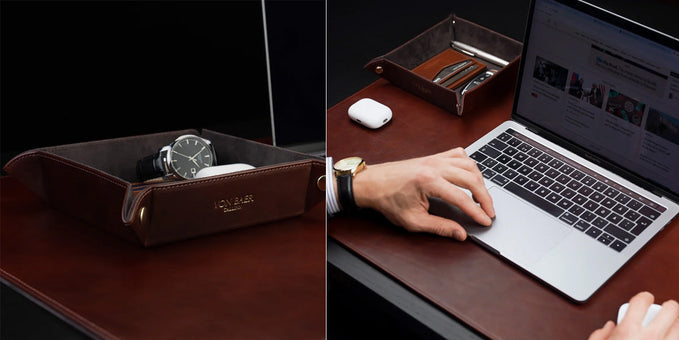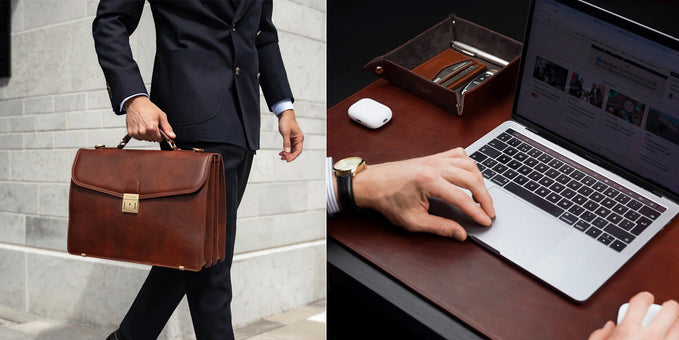How Long Does a Leather Wallet Last?

High-quality full-grain vegetable-tanned leather wallets can last between 5 to 10 years.
Factors that can influence longevity include the craftsmanship, how you use the wallet, and how well you maintain it.
You can extend the lifespan by caring for it properly and protecting it from harsh conditions.
Read more details in our article below:
Leather Quality: The Main Reason for Longevity
Image: Washington Trifold (link)
The choice of leather is a big influence on the longevity of the wallet.
Full-grain leather is the most durable and is noted for retaining the hide's complete fibrous structure.
This type of leather breathes better and resists moisture from prolonged handling. This is essential for preserving the leather's integrity.
At Von Baer, we go even further than this, and use exquisite Cuoio Superiore full-grain vegetable-tanned Italian leather, which has the following unique properties:
- Our leather is sourced from the best Bos Taurus hides, nurtured in Western Europe for superior durability.
- With a 72-hour tanning process, the leather’s strength and texture are unmatched.
- Our unique Tuscan conditioning uses natural oils and tallow, ensuring long-lasting beauty without harmful chemicals.
- Unlike cheaper alternatives, our wallets develop a rich patina over time, enhancing their elegance and character.
You can shop these wallets here.
Lesser grades, such as bonded leather, are manufactured from ground-up leather scraps reconstituted with adhesives and plastics. These are vulnerable to peeling and cracking under stress.
Learn more about leather grades here.
We also wrote an interesting guide on how to choose a quality wallet here.
Advanced Craftsmanship and Construction Techniques
Image: Money Clip Wallet (link)
Advanced crafting techniques can also deliver extra longevity.
Saddle stitching is a method involving two needles on a single thread and delivers are more robust seam than machine stitching.
Waxed threading enhances tensile strength and water resistance.
Critical stress points like corners and folds can benefit from additional stitching.
They can be lined with hidden nylon strips to mitigate tearing.
We wrote about the best styles for men's wallets here.
Usage and Maintenance: Beyond Simple Care
Image: Classic Bifold (link)
Effective maintenance isn’t just about occasional conditioning. You need to understand the specific requirements of the leather.
Vegetable-tanned leather needs different treatments than chrome-tanned leather, for instance.
Vegetable-tanned leather is often used for its eco-friendliness and rich patina development. It benefits from natural conditioning oils.
In contrast, chrome-tanned leather, which is known for its softness and color variety, may need a lighter, water-based conditioner to prevent over-saturation and preserve the dye.
Environmental Influence and Preventive Measures You Can Take
Image: Travel Organizer (link)
The microenvironment around a wallet can speed up wear if you don’t manage it properly.
Prolonged exposure to direct sunlight can degrade the collagen in leather. This can cause stiffness and brittleness.
Humidity creates the growth of mold, which can break down leather fibers.
Preventative storage solutions you can opt for include using breathable cloth bags that shield the leather while allowing air circulation, contrasting with plastic bags that trap moisture.
- Preventive storage: Use breathable cloth bags to avoid moisture accumulation rather than harmful plastic bags.
- Avoid direct sunlight: This stops the leather from becoming stiff and brittle.
If your leather is dry, read about how to rehydrate it here.
Personal Experiences With a Trusted Companion
Image: Minimalist Cardholder (link)
During a business trip to a tropical location, I found that a well-maintained, vegetable-tanned leather wallet not only kept my essential cards accessible but also resisted humidity-induced damage, thanks to pre-trip conditioning.
The preventative steps I had carried out ensured that my wallet maintained its shape and texture in spite of challenging weather conditions.
This emphasizes the importance of tailored leather care based on environmental expectations.
Key takeaways
- Opt for high-quality full-grain leather for its durability and resistance to moisture.
- Seek wallets that feature saddle stitching and waxed threads for better durability.
- Tailor leather care to the type of leather your wallet is made from and recognize the specific requirements of vegetable-tanned versus chrome-tanned leathers.
- Protect your leather from environmental factors by opting for appropriate storage solutions.
What are the best methods for cleaning a leather wallet?
General cleaning should involve gently wiping the surface with a soft, damp cloth.
This helps to remove surface dirt and dust.
If you have deeper stains to deal with, you can use a specialized leather cleaner.
Don’t use household cleaners and chemicals that can damage your leather.
We wrote a full guide on this here.
How often should I condition my leather wallet?
This depends on factors like the climate and how often you use the wallet.
I recommend that you condition the item every three months if it is regularly exposed to the elements or if you live in a dry climate (we recommend this Premium Leather Cream).
If this is not the case, you may only need to condition it every three months to keep the leather supple and prevent cracking.
What are the differences between chrome-tanned and vegetable-tanned leather in more detail:
- Chrome-tanned leather is treated with chromium salts. This means the leather is softer and more pliable. It also means it’s available in a wide range of colors. It’s generally more water-resistance and is less susceptible to stains than vegetable-tanned leather. This is why it’s so popular for everyday use.
- Vegetable-tanned leather uses organic materials and tannins from tree bark. This produces a stiffer and more robust leather that develops a rich patina over time. It is environmentally friendlier but needs more care to maintain its appearance.
We highly recommend choosing vegetable-tanned leather, as it's far more environmentally friendly, and develops a more appealing patina over time.
Are there any specific conditions under which I should not use a leather wallet to extend its lifespan?
Don’t use leather wallets in extremely wet conditions and avoid overstuffing them.
Stretching the leather can cause irreversible deformations and weakened seams.
What should I do if the leather gets wet?
If your wallet gets wet, pat it dry with a soft cloth and allow it to air dry naturally away from direct heat sources.
These can cause the leather to warp or crack.
Once the item is dry, apply a conditioner to help restore moisture to the material.
See our article on how to dry a leather wallet here.
Are there any signs that suggest it’s time for me to replace my leather wallet?
Signs it’s time to think about replacing your wallet include noticeable tears in the leather, seam rips that can’t be repaired, permanent misshaping from overstuffing, or severe cracking or fading of the leather that conditioning is no longer able to fix.

Author: Igor Monte
Igor Monte is the co-founder of Von Baer. He's an expert in all things premium leather, from being an end-user right up to the design and manufacturing process. His inside knowledge will help you choose the best leather product for you.
We strive for the highest editorial standards, and to only publish accurate information on our website.
Leave a Comment
Your email address will not be published.











